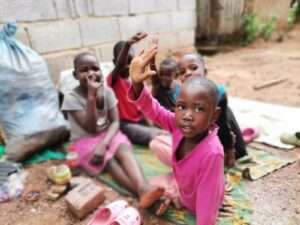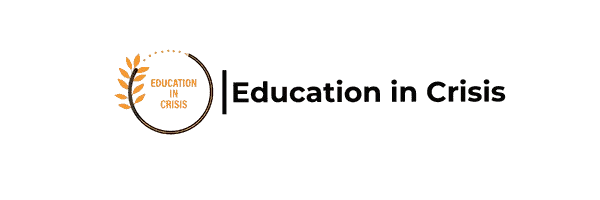To promote inclusive, equitable quality education for poverty alleviation and sustainable development

- Breakdown:
- Promote: EiC is proactive in advocacy, programming, and policy influence for education.
- Inclusive: Ensuring marginalized, displaced, or vulnerable children—especially girls—are not left behind.
- Equitable: Focuses on fairness, giving all learners the support they need to succeed.
- Quality Education: Consistently working to raise the standard of learning, curriculum, teaching, and infrastructure.
- Poverty Alleviation: Education is leveraged as a key tool for breaking the cycle of poverty.
- Sustainable Development: Links education to broader global goals—social, environmental, and economic.
The Strategic Plan 2025–2029
The Education in Crisis (EiC) Strategic Plan 2025–2029 is a bold and actionable roadmap for transforming education in crisis-affected regions across Africa. Rooted in our vision of inclusive, equitable, and quality education for all, the plan outlines EiC’s priority areas, guiding principles, and innovative approaches to reach the most marginalized children and youth. It reflects our deep commitment to addressing barriers in education caused by conflict, displacement, gender inequality, and poverty. Through targeted interventions in education in emergencies, gender equity, school feeding, technology, teacher training, and policy advocacy, EiC seeks to create systemic change that empowers communities and builds lasting resilience.
We encourage stakeholders, partners, and supporters to explore the full strategic plan to understand our impact framework, regional priorities, and how we intend to scale our work. The plan provides critical insights into EiC’s theory of change, results framework, and investment strategies over the next five years. To learn more, we invite you to download the full EiC Strategic Plan 2025–2029 here, or visit our Strategic Priorities page for thematic deep dives. Together, we can ensure no child is left behind—even in the most challenging circumstances.
Our mission drives us to work in fragile and emergency settings, ensuring that no child is forgotten. We champion education in emergencies, protect learning rights, and build systems that allow every child to learn, no matter the challenges they face.
Every child deserves a chance. Be the reason they smile today.
 Who We Serve
Who We Serve
We work with children and youth living in displacement, conflict zones, underserved rural areas, and communities affected by poverty and crisis—especially in Sudan, South Sudan, Uganda, Kenya, and Tanzania.
- Education Challenges
- Limited Access to Education in Conflict Zones
- Gender Inequality and Barriers to Girls’ Education
- Severe Shortage of Qualified Teachers
- Inadequate School Infrastructure and Learning Materials
- Insufficient Education Financing and Weak Policy Implementation
Africa’s Top 5 Education Challenges
Education in Crisis (EiC) is committed to addressing the most pressing education challenges across Africa, particularly in fragile and conflict-affected contexts.
A world where every child, even in crisis, has access to free, quality education. At Education in Crisis (EiC), we envision a future where children are not held back by conflict, poverty, or displacement—but are empowered through education to rebuild their communities, lead change, and thrive.
Problem: Limited Access to Education in Conflict Zones
The Challenge: Armed conflict, displacement, and instability have left millions of children in countries like Sudan and South Sudan without access to schools. Infrastructure is destroyed, teachers are displaced, and children face protection risks while attempting to learn.
EiC’s Solution: Establish safe, inclusive, and adaptive learning opportunities that meet the urgent educational needs of children living in or fleeing from conflict zones.
Strategic Action:
- Deploy temporary learning spaces and mobile education units in displacement sites and conflict-affected regions.
- Scale up Accelerated Learning Programs (ALPs) tailored to help overage children catch up and reintegrate into formal education.
- Collaborate with local education authorities and humanitarian clusters to ensure EiC programs are coordinated, compliant, and conflict-sensitive.
Introduce EiC’s Education Crisis Response Dashboard to track learning disruptions and facilitate rapid education response planning.
Problem: Gender Inequality and Barriers to Girls’ Education
The Challenge: Cultural norms, early marriage, poverty, and lack of safety prevent millions of girls across Africa from enrolling and staying in school. Girls in humanitarian settings face higher risks of gender-based violence (GBV), exploitation, and school dropout.
EiC’s Solution: Promote a safe, gender-responsive education system that protects, empowers, and advances girls’ right to learn.
Strategic Action:
- Implement the “Her Class, Her Rights” initiative to create girl-friendly spaces within schools.
- Provide scholarships, school kits, and menstrual hygiene materials to girls from low-income households.
- Establish Girls’ Support Committees, leadership clubs, and mentorship opportunities with female educators.
- Train school staff on GBV prevention, reporting mechanisms, and inclusive classroom practices.
- Advocate for national policies that ban child marriage and protect the rights of girls to education.
Problem: Severe Shortage of Qualified Teachers
The Challenge: Many African countries lack trained teachers, especially in rural and crisis-affected regions. Where teachers are available, many are underpaid, poorly trained, or unprepared for the challenges of teaching in emergencies.
EiC’s Solution: Improve teacher training, recruitment, and support to ensure children have access to quality, committed educators.
Strategic Action:
- Launch EiC’s Teacher Capacity Strengthening Program targeting displaced and local teachers, particularly women.
- Partner with teacher training colleges to deliver in-service modules on child protection, psychosocial support, and inclusive pedagogy.
- Offer stipends and support to para-teachers in remote locations.
- Promote teacher wellness and professional growth through coaching, peer learning, and recognition platforms.
Develop a regional network of Women Educators in Emergencies (WEE) to foster peer mentorship and retention.
Problem: Inadequate School Infrastructure and Learning Materials
The Challenge: In many parts of Africa, schools lack classrooms, clean water, latrines, electricity, furniture, and basic supplies. This leads to overcrowding, poor learning conditions, and health risks—especially for girls.
EiC’s Solution: Equip learning environments with the infrastructure, tools, and nourishment needed to ensure education is safe, engaging, and child-friendly.
Strategic Action:
- Construct and rehabilitate classrooms using community-based, cost-effective models.
- Install gender-sensitive WASH facilities in schools to support girls’ retention.
- Distribute learner kits, textbooks, teacher manuals, and digital devices where feasible.
- Scale EiC’s Relief Kitchen school feeding program to reduce hunger and improve attendance.
- Introduce solar-powered digital learning hubs in off-grid communities.
Problem: Insufficient Education Financing and Weak Policy Implementation
The Challenge: Government spending on education in many African countries remains below the recommended 20% of the national budget. Policies are often underfunded, poorly monitored, or not inclusive of displaced and marginalized children.
EiC’s Solution: Strengthen advocacy to influence education policy, mobilize domestic and external resources, and ensure accountability to children’s rights.
Strategic Action:
- Lead the “1 Million Africans for Education” campaign to rally citizens in support of increased education funding.
- Engage ministries of education and national parliaments to influence budget allocations and implementation.
- Participate in global and regional education policy platforms, such as SDG4 consultations, AU forums, and ECW partnerships.
- Publish annual education scorecards and impact reports to promote data transparency and policy dialogue.
- Train youth advocates to lead civic engagement on education rights in their communities.

 DONATE NOW AND SUPPORT OUR MISSION.
DONATE NOW AND SUPPORT OUR MISSION.